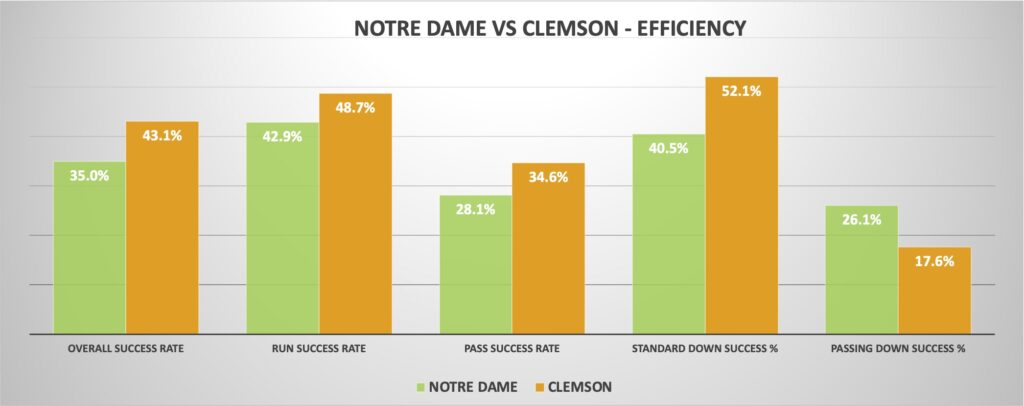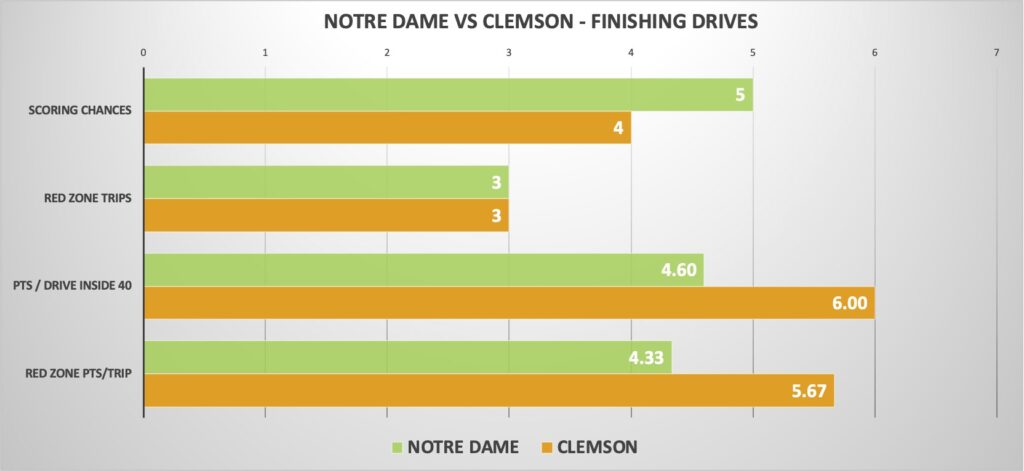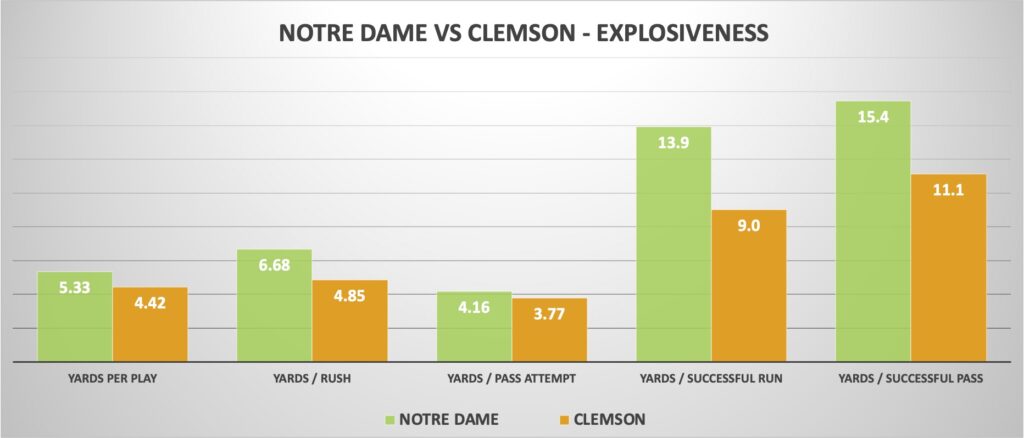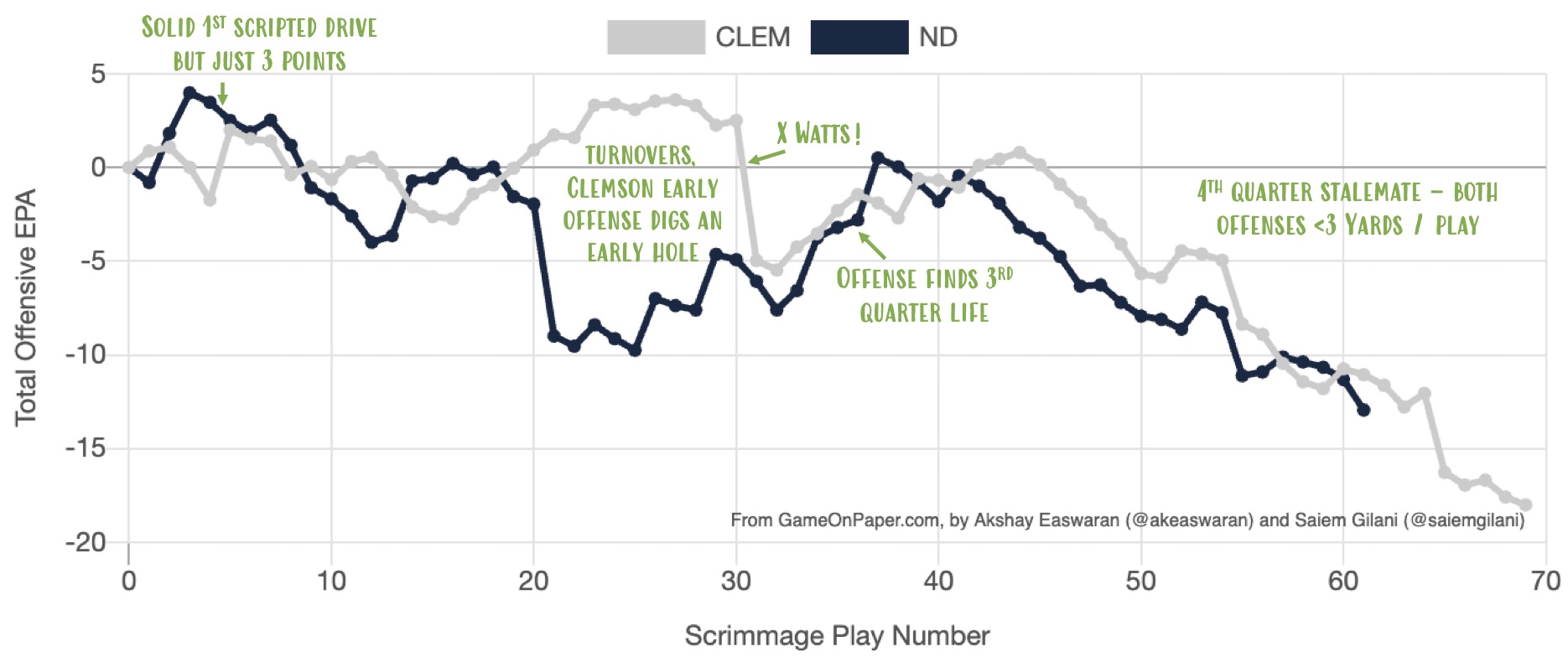The Notre Dame trip to Clemson ended up as a toss-up in the final numbers – SP+ gave the Irish a 43% expected win probability and an adjusted margin of -1.5 points. ND outgained the Tigers by nearly a yard per play, created more scoring chances, and were +1.22 in expected turnovers (only to finish -1). But the struggling Garrett Riley offense was surprisingly still more efficient, including finishing drives, and kept Marcus Freeman’s team at arms length down the stretch – including a 4th quarter where neither team cracked 3 yards per play.

After the joyous home routes of USC and Pitt, this was a jarring reality check with the Irish struggling for a third straight road game. The coaching staff continue in-game clock and decision-making blunders, the offense again looked disjointed and unable to prevent or respond to pressure, and the defense didn’t meet expectations despite giving Notre Dame late chances to rally.
No garbage time in this game, only Clemson end of game kneeldowns were removed.
Stats from a few excellent sources – College Football Data, Game On Paper, and often referencing SP+ and FEI metrics. If you get lost, check out this handy advanced stats glossary here or reach out in the comments.
An offense (and opportunity) lost

Many aspects of Notre Dame’s road trips weren’t perfect, but the defining parts of the Clemson loss were the bookend poor performance by the Irish offense that helped dig an early hole and cement defeat late. The opening drive looked promising for the Irish, only to quickly stall in scoring territory with same bizarre play-calling to set up a field goal rather than a fourth down attempt. After two straight 3-and-outs, the next drive again stalled in the red zone leading to another field goal. These early kick decisions are defensible in a vacuum – you could argue that early in the game, Freeman and Parker were still anticipating a low-scoring affair. But as the game unfolded these mistakes compounded, and the sequencing (i.e. 3rd and 10 runs) never made sense even in the moment.
Four drives into the game the Irish had two scoring chances but trailed 17-6. Sam Hartman then threw a pick-six to Jeremiah Trotter I’m still trying to erase from my memory, and things looked bleak. The offense still showed signs of life moving the ball, but the 6th Irish drive again lost momentum in close and yielded another questionable field goal attempt. Maximizing those scoring efforts killed Notre Dame, as in the second half they managed just one offensive possession that gained more than 20 yards.

Sam Hartman picked an inopportune time for his worst passing game, compensating some with his biggest rushing day in a Notre Dame uniform but unable to find any efficiency. He struggled both in a clean pocket and also under constant pressure, with the two costly interceptions and some other near misses for Tiger defenders. The degree of difficulty was extremely high for Hartman, but balls simply weren’t on target in key moments (screens to Gi’Bran Payne and Chris Tyree that had the makings of explosive plays, a late deep ball to an open Jordan Faison that was underthrown to name a few).
It’s a disappointment it looks like we won’t have a signature Hartman performance in an ND uniform, given the low stakes of the last few games. The Gerad Parker offense and issues with finding healthy receivers to separate have turned Hartman’s thesis defense into an onslaught he’s been unable to adapt to (author’s note: I’ve never had to do one of these, but hopefully you get the point). But the idea of leaving Wake Forest and finding life easier with a complementary run game and strong offensive line to protect him certainly hasn’t panned out the way it was expected, and Hartman’s penchant for costly turnovers has followed him into ACC games despite the uniform change.
It’s a missed opportunity, because the quickest way to make the leap to playoff contention is a dynamic passing game and blue chips receivers (hello Washington, Oregon, USC last year, FSU, maybe Texas?). Hartman was a chance to get the snowball rolling downhill – that Notre Dame’s passing offense can look dangerous, and is close to meeting the requisite level of volume and dynamic play-calling and development that would convince a recruit or portal resident that a stop in South Bend significantly advances their NFL goals.
The magic run for Al Golden’s defense ends

After the USC and Pittsburgh performances, there were some justifiable comparisons being made to the recent great defenses in 2012 and 2018. But part of the key differences between those teams and this edition is the talent level overall and especially in the front seven. Al Golden’s team has executed at an extremely high level but seen some hiccups with tackling and dips in play on the road, and lacks some of the NFL upside to compensate for those blips.
This game didn’t check out as a poor performance defensively by any means – less than 5 yards per play and an average success rate allowed is respectable. But given the weaknesses flashed by Clemson’s offense, it was disappointing by their own standard that the ND defense couldn’t do more to disrupt Klubnik and the run game. Phil Mafah was extremely efficient and explosive early, and the game-end numbers were softened by a lockdown 4th quarter while Clemson happily played the field position game and sat on the ball.

The Irish were statistically unlucky on the turnovers, only coming away with one interception and one fumble recovery on a wealth of Clemson opportunities (including some self-inflicted with poor snaps and hand-offs).
On to a weird offseason
(Just kidding, there’s still two games left).
Still, with a major New Year’s bowl appearance off the table a lot of focus now shifts anxiously towards what could be another tumultuous offseason. Staff changes, roster management with a ton of returning veterans with eligibility, managing the portal – it should be another wild ride.
But it’s worth taking a second to reflect on a strange season for Marcus Freeman in Year 2 – it’s been a long time since Notre Dame has performed at this high of level but underwhelmed in the W-L columns. By consensus metrics the Irish are a borderline top-10 team – does Freeman earn credit for continuing to shape the roster and perform at this level after Brian Kelly? Or is the underperformance against that more damning?
📉Week 12 Composite Ratings📈
#1 – America’s Team
#2 – Take your pick! Ohio State/Oregon/Georgia separated by less than 1 point
#5/6 – Penn St/Alabama
#7-13 separated by 3 points@ESPN_BillC@bcfremeau@beta_rank_fb@KFordRatings@CFBWinningEdge pic.twitter.com/g1PkKFEryU— Nate Manzo (@cfbNate) November 14, 2023
Against many recent schedules (2018, 2020, 2021) and with better pacing (these two late bye weeks are atrocious planning) this Notre Dame team could easily still be in playoff contention. It’s a bad combination of timing exacerbated by a roster depth issues, injuries, and some poorly constructed offense. For as tempting as it is to write this season off as a failure, many of the underlying signals about this tenure are still positive with regards to recruiting and development. The over/under win total for this team was 8.5 games for a reason.
The in-game decision-making needs an overhaul, but it’s an easier skill to learn or delegate than many. Freeman’s initial instincts to pursue Collin Klein and Andy Ludwig were strong. The inability to land transfer portal receivers to fill glaring gaps in the roster is not being Marcus is being picky.
Living through the growing pains is hard, and some of the early red flags emerging could ultimately prove fatal to the Freeman era. Winning is too hard, the margins too thin, and this sports is too unpredictable to assume there are easy answers. This season feels like a missed opportunity, but it shouldn’t be the only opportunity, and these final two games will set the stage for another big-picture test for Freeman – one that hopefully he’s even more prepared for each December.





Extremely balanced, excellent judgments, well written — I should say thank you: eh bien, merci !
You really set up the transition to the critical Year 3. Gut check time for the young coach.
For what it’s worth, almost all modern-era ND coaches have had disappointing/underwhelming second seasons.
Kelly: Started ranked 16, went 8-5 with a loss in the Champs Sports Bowl to FSU, finished unranked.
Weis: Started ranked 2, went 10-3 with a loss in the Sugar Bowl to LSU, finished ranked 17/19.
Willingham: Started ranked 20, went 5-7 with no bowl. Finished unranked.
Davie: The outlier! Started ranked 22, went 9-3 with a loss in the Gator Bowl to GT, finished ranked 22.
Lots to work on this offseason, but in the very big picture, a disappointing second year for Freeman doesn’t mean much one way or the other. We’ll find out what we have next year.
I think we are still at a point where winning out, including a bowl game against a mediocre opponent, would be an improvement over last season. But a bowl game wouldn’t be a home game, so we are probably at a pretty comparable year to 2022. Fewer bad losses, but no great wins.